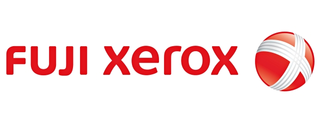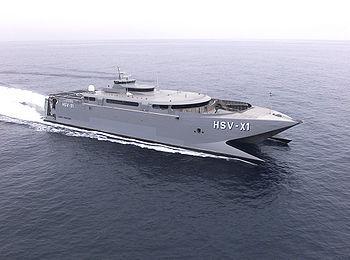
English: Logo of Fuji Xerox, joint venture between Fuji Photo Film Co. and Xerox (Photo credit: Wikipedia)
This chapter explores three closely related topics: the decisions of which markets to enter, when to enter those markets, and on what scale.

HSV-X1 Joint Venture 020802-N-8894M-003 Pacific Ocean (Aug. 2, 2002) — The high-speed vessel “Joint Venture” (HSV-X1) moves through the waters off the coast of southern California. Joint Venture is participating in Fleet Battle Experiment Juliet (FBE-J) as part of operations supporting Millennium Challenge 2002 (MC-02). MC-02 is the nation’s premier joint integrating event, bringing together both live field exercises and computer simulations throughout the Department of Defense. (Photo credit: Wikipedia)
When a firm that wishes to enter a foreign market, it has several options, including exporting, licensing or franchising to host country firms, setting up a joint venture with a host country firm, or setting up a wholly owned subsidiary in the host country to serve that market. Each of these options has its advantages and each has its disadvantages.
Strategic alliances have become more frequent. They may be seen as one way for firms to enter into cooperative agreements between actual or potential competitors. The term “strategic alliances” is often used rather loosely to include a wide range of arrangements between firms, including cross-share holding deals, licensing arrangements, formal joint ventures, and informal cooperative deals.
The magnitude of the advantages and disadvantages associated with each entry mode are determined by a number of different factors, including transport costs and trade barriers, political and economic risks, and firm strategy.
The opening case explores how General Motors focused on China as its next growth market. The company used a joint venture strategy in the market and by 2010 sold more cars in China than in the United States.
The closing case discusses General Electric’s changing perspective on the value of joint ventures as a market entry mode. In the past, General Electric has avoided joint ventures and the shared control they imply when entering foreign markets, but more recently, the company has embraced the entry mode as a means of acquiring knowledge of the local market.
Learning objectives
1. Explain the three basic differences that firms contemplating foreign expansion must make: which markets to enter, when to enter those markets, and on what scale.
2. Compare and contrast the different modes that firms use to enter foreign markets.
3. Identify the factors that influence a firm’s choice of entry strategy.
4. Recognize the pros and cons of acquisitions versus greenfield ventures as an entry strategy.
In your opinion, has General Motors’ approach to China paid off? Was the company’s decision to make a significant commitment to the market a good one?
Another Perspective: To explore General Motors’ Chinese operations in more depth, go to {http://www.gmchina.com/} and click on “English”.
Another Perspective: To extend this case, consider {http://www.businessweek.com/news/2011-10-11/general-motors-looks-at-india-asia-africa-for-more-capacity.html} and {http://www.businessweek.com/news/2011-03-15/great-wall-motor-net-more-than-doubles-as-china-car-sales-surge.html}.
LECTURE OUTLINE FOR CHAPTER:
Slide 15-3 Basic Entry Decisions
Firms expanding internationally must decide which markets to enter, when to enter them and on what scale, and which entry mode to use. Entry modes include exporting, licensing or franchising to a company in the host nation, establishing a joint venture with a local company, establishing a new wholly owned subsidiary, or acquiring an established enterprise.
Slide 15-4 What Influences Entry Mode Choice
Several factors affect the choice of entry mode including transport costs, trade barriers, political and economic risks, costs, and firm strategy.
Slides 15-5-15-6 Which Foreign Markets?
The choice of foreign markets will depend on their long run profit potential.
Slides 15-7-15-9 Timing of Entry
Once attractive markets are identified, the firm must consider the timing of entry. Entry is early when the firm enters a foreign market before other foreign firms, and late when the firm enters the market after firms have already established themselves in the market.
First mover advantages are the advantages associated with entering a market early. First mover disadvantages are disadvantages associated with entering a foreign market before other international businesses.
Slide 15-10 Scale of Entry and Strategic Commitments
After choosing which market to enter and the timing of entry, firms need to decide on the scale of market entry. Large-scale entry may keep rivals out and may stimulate indigenous competitive response. Small-scale entry allows time to learn about the market and reduces risk exposure.
Slide 15-11 Which is Best?
There are no “right” decisions when deciding which markets to enter, and the timing and scale of entry, just decisions that are associated with different levels of risk and reward.
Slides 15-12-15-14 Entry Modes
The six entry modes are exporting, turnkey projects, licensing, franchising, joint ventures, and wholly owned subsidiaries.
Slide 15-15 Exporting
Exporting avoid costs of investing in new location and may help achieve experience curve and location economies. Exporting faces challenges from tariff barriers, transportation costs, control over marketing, and local low-cost manufacturers.
The Business Link {http://www.canadabusiness.ca/eng/} provides information companies should know before they begin exporting. Students can click on the various topics to learn more about export financing, export plans, dealing with risk, and so on.
Slide 15-16 Turnkey Projects
Turnkey projects allow a company to get a return on knowledge assets and are less risky than conventional FDI. The disadvantages are that there is not long-term interest in the location, the project may create a competitor, and if process technology is involved, the firm may be selling a competitive advantage.
To learn more about how one company, Ashoka Technologies, organizes turnkey projects for clients go to {http://www.turnkey-projects.com/turnkey-plants.html}.
Slide 15-17 Licensing
Licensing does not bear the costs and risks of investment and avoids political/economic restrictions in a country.
Slide 15-18 Franchising
Franchising reduces costs and risks, avoids political and economic restrictions, and allows for quicker expansion. Disadvantages include loss of control over quality.
Slides 15-19-15-20 Joint Ventures
Joint ventures benefit from the local partner’s knowledge, shared costs, and reduced risk.
Disadvantages include loss of control over technology and conflict between partners.
1000ventures, available at {http://www.1000ventures.com/business_guide/jv_main.html} is a web site that offers a wealth of information about joint ventures.
Another Perspective: Ford recently entered a joint venture with Toyota to build hybrid pickup trucks. To learn more about why the arrangement made sense for both companies go to {http://www.businessweek.com/news/2011-08-22/ford-to-join-with-toyota-to-develop-hybrid-pickup-trucks-suvs.html}
Slide 15-21 Wholly Owned Subsidiaries
Wholly owned subsidiaries offer the most control and the highest level of risk and cost.
Slide 15-22 Selecting an Entry Mode
The optimal choice of entry mode involves trade-offs.
Slide 15-23 Core Competencies and Entry Mode
The optimal choice of entry mode for firms pursuing a multinational strategy depends to some degree on the nature of their core competencies.
Slide 15-24 Pressures for Cost Reductions and Entry Mode
When pressure for cost reductions is high, firms are more likely to pursue some combination of exporting and wholly owned subsidiaries.
Slides 15-25-15-26 Greenfield Ventures or Acquisitions
Firms can establish a wholly owned subsidiary in a country through a greenfield strategy (building a subsidiary from the ground up) or through an acquisition strategy.
Slide 15-27 Pros and Cons of Acquisitions
Pros: quick, preemptive, possibly less risky. Cons: disappointing results, overpay, optimism/hubris, culture clash, failure of synergies
Slide 15-28 Pros and Cons of Greenfield Ventures
Greenfield ventures allow the firm to build the subsidiary it wants, but it is slow, risky, and may involve preemption by competitors.
Acquisition is quicker, so a consideration if there are competitors ready to enter.
Slide 15-29 Strategic Alliances
Strategic alliances refer to cooperative agreements between potential or actual competitors.
Slide 15-30 The Advantages of Strategic Alliances
Strategic alliances facilitate entry into a foreign market, allow firms to share the fixed costs (and associated risks) of developing new products or processes, bring together complementary skills and assets that neither partner could easily develop on its own, can help a firm establish technological standards for the industry that will benefit the firm.
Strategic alliances can give competitors low-cost routes to new technology and markets, but unless a firm is careful, it can give away more than it receives.
The firm must be certain that the partner is one that can help the firm achieve its goals and not act opportunistically to exploit the alliance purely for its own ends.
Another Perspective: Virgin Atlantic is exploring the possibility of forming a strategic alliance in order to achieve its growth objectives. To learn more about what the company is looking for in a partner, see {http://www.businessweek.com/news/2011-06-16/branson-could-cut-stake-to-aid-virgin-atlantic-alliance-search.html}.
Slides 15-31-15-33 Making Alliances Work
The success of an alliance is a function of partner selection, alliance structure, and manner in which the alliance is managed.
Another Perspective: The Association of Strategic Alliance Professionals {http://www.strategic-alliances.org/} is an organization devoted to the formation of successful strategic alliances. The organization is supported by a number of well-known global companies, and provides information on the involvement of the companies in strategic alliances.

World locations of Fiat Group automobile manufacturing sites (own,license and joint ventures). (Photo credit: Wikipedia)

